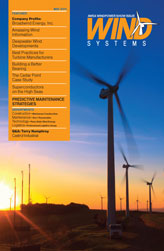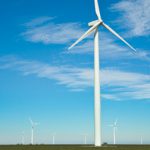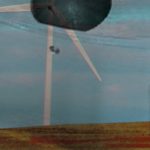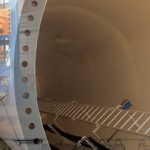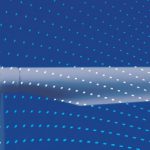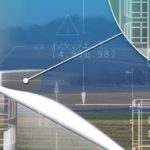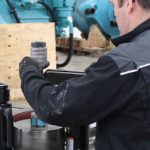When it comes to wind information, much attention is focused on the choice of wind measurement technology and data collection practices in wind resource assessment and project design. Right now, wind data plays a limited role in the day-to-day operations and maintenance (O&M) of a wind farm once it is built. As wind measurement technology evolves and adoption of new methods increases, the same new technologies that are being used in the pre-development phases of a wind farm will also hold promise for improving productivity of wind farms after they are built.
Wind Information Lifecycle
Wind information has a lifecycle, with phases corresponding to the development and operational stages of a wind farm. Collection and maintenance of high quality wind information throughout the project lifecycle can be a vital part of your ongoing O&M strategy and useful for future planning purposes. Consider that a typical power purchase agreement is usually 15-20 years or more, and wind land leases can be 50-100 years in length. Twenty years from now when your turbines have reached end of life and more efficient turbine and blade technologies are available, you will be well prepared to calculate financial returns on various re-powering alternatives if you have collected and archived in-depth information about the local wind resource. We don’t know what wind turbines of the 2030s will look like, but turbine hub heights have nearly doubled over the last two decades, and the increase in height is projected to continue.
Wind Information and O&M
The foundation for successful wind turbine monitoring and plant optimization begins with wind data collected during the pre-construction phases. Analysis of turbine rotor height data collected during the wind farm design phase of project engineering can aid in development of optimal operating strategies. For example, turbulence and inflow angle can be seen with wind measurements taken prior to construction. Once in the operations phases, turbulence and wake effects can be measured with portable wind profilers and mitigated though smart wind sector management approaches that dictate when some wind turbines might have to be switched off if they are operating in the wake of a neighboring wind turbine.
Profitability during the operations phase depends on maximizing power production and minimizing ongoing maintenance, especially unscheduled maintenance events associated with equipment breakdown. Since the cost of maintaining a wind turbine goes up with age—averaging about 10 percent of total wind farm operating costs during the early years and approaching 35 percent of operating costs as the turbine nears the end of its useful life—minimizing repair costs by improving operational practices can substantially increase wind farm profitability. So how can wind data contribute to improved production and reduced maintenance over the life of the wind farm?
Ongoing wind monitoring traditionally involves a handful of meteorological masts equipped with cup anemometers mounted at or near hub height, but recent increases in turbine height to 100 meters and higher makes this impractical. The number of masts used typically decreases between the assessment/design stage and the operations stage, meaning less data to inform decisions during operations. Increasing hub heights drives up the cost of hub-height monitoring, and makes larger guyed masts harder to incorporate into wind farm layouts.
Until recently reliable collection of turbine-height wind speed and direction data has been tedious at best, and prohibitively expensive in many cases. Historically, field measurement solutions employed 80-meter lattice-construction met masts equipped with numerous weather sensors. These towers cost on the order of $100,000 to erect, take many months to secure permitting, require Federal Aviation Administration (FAA) and Air Force approval in the United States and other types of permitting in most other countries, and need a steady power supply to operate the signal beacons.
Hub-height met masts and mechanical sensors are prone to failures caused by icing, windstorms, tornados, and other severe weather, and they have significant ongoing maintenance costs, resulting in a five-year lifecycle cost of as much as $200,000 to $250,000 each.
More recently, modern “remote sensing” wind profilers employing Sodar (Sonic Detection and Ranging) or Lidar (Light Detection and Ranging) technology are being used to get accurate data at hub height and beyond. These relatively new devices have the ability to accurately measure wind speed and direction across the entire rotor sweep and can detect inflow angles, turbulence, and wake effects. Remote sensing systems have a small footprint compared to a mast and are highly portable for temporary placement around a wind farm. When connected to an operations team with near real-time communications, remote sensing data collection has the potential to support four essential functions: power curve testing, load analysis, condition monitoring, and forecasting.
Power Curve Testing
A turbine purchase contract typically includes a guaranteed power curve which warrants expected energy output at given wind speeds at that site. When the turbine doesn’t deliver the expected power, warranty service and/or financial compensation may be in order. Formal power curve testing is usually administered according to International Electrotechnical Commission (IEC) standards that still require traditional anemometers, and is normally conducted while the wind farm is under construction because wake effects from neighboring turbines will affect the results. The assumption that a single-point hub-height wind speed is representative of the wind over the entire turbine rotor worked for small wind turbines, but is not applicable to modern turbines with 80- or 100-meter rotors.
Wind shear (speed changes that vary with height), veer (directional changes that vary with height), and turbulence caused by terrain or weather conditions require a more accurate wind measurement across today’s turbine rotor. Proven accuracy, rapid deployment, and portability make remote sensing technology the logical choice for future power curve testing, and field tests are taking place now.
Load Analysis
The wind industry is continually working to better understand the actual operating loads that affect today’s massive turbines. Wind turbine load testing and analysis determines how turbines withstand the forces they’re subjected to. Wind turbines and supporting structures are subjected to an almost constant barrage of wearing forces. Wind shear, veer, and turbulence take a constant toll on turbine gears, shafts, bearings and housings; performance in the field has not always matched that which can be modeled in a computer. Some standards have been created to allow the industry to design turbines with improved reliability, but the lack of good wind data has limited improvements. Turbine blades still crack, main shafts flex too much, bearings overheat, and gearboxes lose teeth. Knowing the wind conditions that cause these failures is critical to determining viable operating strategies.
The question for wind plant operators is whether the wind loads hitting the turbine are within its design envelope, and whether potential wear and tear on the machines outweighs the value of the electrical production. Taking turbines offline in certain damaging wind conditions may prove to be far more cost-effective than leaving them operating. However, knowing when to make this tradeoff requires reliable, accurate wind information.
Condition Monitoring
New hardware and software solutions for wind turbine condition monitoring can help indicate changes in turbine performance and allow operators to measure and record a wide range of turbine operating parameters. However, typical condition monitoring makes no correlation between turbine operation at any given moment and the wind forces hitting the rotor at that same moment. Although most wind turbines are designed to withstand a 100-year occurrence, at some sites turbines can be subject to conditions like that several times a month. Those extremes put enormous stress on the turbine components; accurate wind information allows operators to make operational decisions that can either improve performance or minimize equipment damage.
Most turbines now have heat and vibration sensors that trigger alerts when gearboxes are getting too hot or the equipment is vibrating too much. While these sensors are helpful, they don’t enable proactive turbine management; they’re akin to the “check engine light” in the average car. By the time the alarm trips, extreme conditions could have already damaged the turbine.
Wind data that reveals how the damaging conditions were created increases the value of condition monitoring. What wind forces were hitting the turbine blades? What pitch were the blades at when the gearbox started to heat up? What direction was the wind blowing? What was the yaw angle? How much shear was there? Operators need a greater base of recorded wind data so they can correlate conditions with actual wear and tear on the turbines. With that information in hand, operators can develop operating strategies that may prevent serious gearbox and rotor damage, which often means lengthy downtime and loss of revenue.
Forecasting
To meet its full potential, wind energy must be integrated into utility systems where reliability is critical. Wind forecasting tools have been proven to minimize costs and ensure reliability, but their accuracy in near-term forecasting has suffered from lack of real-time wind data. Several studies are currently underway that show it may be possible to dramatically improve forecast results by accurately collecting and reporting actual turbine height wind speed and direction measurements and providing them to forecasters in near real-time. These measurements can be taken on-site or near-site and even regionally to get a look ahead at what wind conditions are approaching a wind farm. Accurate near-term forecasting of wind energy is heavily reliant on observed data because the timing of rapid weather changes such as thunderstorms is very difficult to predict without good quality field observations.
Numerical weather models are typically initialized with National Weather Service gridded data sets that are by nature at least one hour old by the time they can be accessed, ingested, and processed by the modeling software. Thus, forecasting in the hour-ahead timeframe may be improved with wind observations, both at and around a wind farm.
Early detection of weather fronts and other severe storm events is critical to predicting so-called “ramp events.” A ramp event is a period of rapid change in wind farm production caused by rapid change in wind speed. There is no clear industry definition of how much change or what timeframe constitutes a ramp event. In fact, the amount of wind speed change required to cause concern will vary depending on the grid system in question. One thing is certain, ramp events are of interest to independent system operators because they must have operating strategies in place to deal with any impact the events may have on generation capacity and system reliability.
High quality observed wind data is particularly useful to assist human forecasters—still the best way to determine the timing of weather fronts—as input to computational learning systems, and for rapid assimilation into custom high-resolution numerical weather prediction models.
The same handful of met masts on wind farms that are used for ongoing wind monitoring are used to enhance wind forecasts, and the same shortcomings apply. The number and placement of towers on-site may not reflect wind conditions across the site, and sensors below hub height are missing most of the productive winds that the turbine sees. Remote sensing can provide measurements at hub height and above, with easier upwind placement and added data like inflow angle that is difficult to measure with mast-based sensors.
Looking Ahead
The wind industry is experiencing a period of rapid evolution. Innovations in turbine technology have brought improvements in the amount of power that can be extracted from a given amount of land, but have created the need for more innovative wind measurement applications and wind data collection practices. The measurement technologies and data management systems that are today being deployed in pre-development applications hold great promise for the operations side of the wind information lifecycle. As wind information technologies, practices, and applications evolve to meet the needs of operating wind farms, wind farm operators must move to an integrated infrastructure that uses wind data—both current and historical—to make wind farms more productive and profitable.
Wind is a variable resource, but not an indecipherable one. Wind farm operators can improve turbine performance while minimizing wear and damage by employing the full range of wind sensing technology available today in an integrated infrastructure that informs monitoring and optimization. That process begins with treating wind data as a living asset that documents a site’s historic wind patterns and adds value to its future.



















